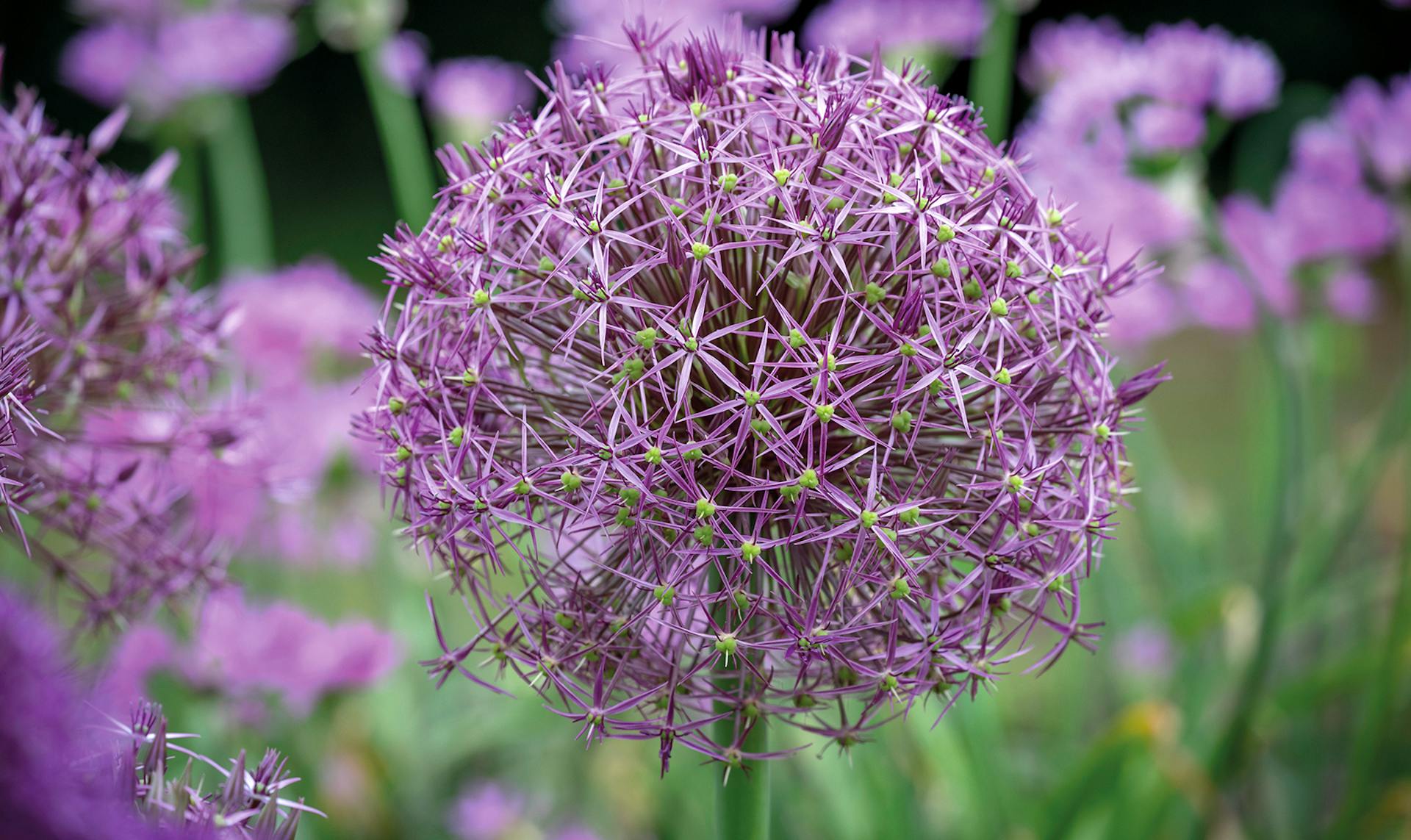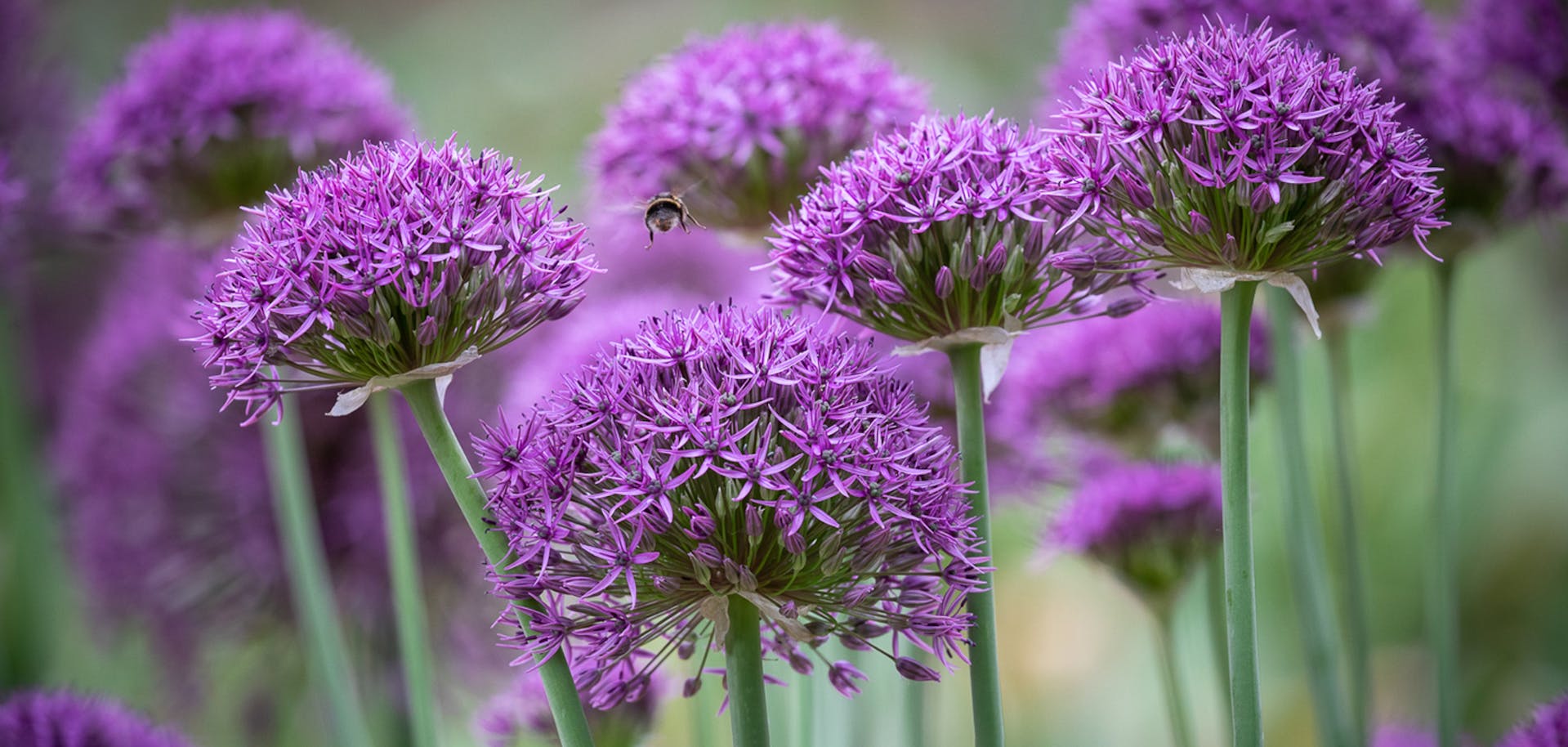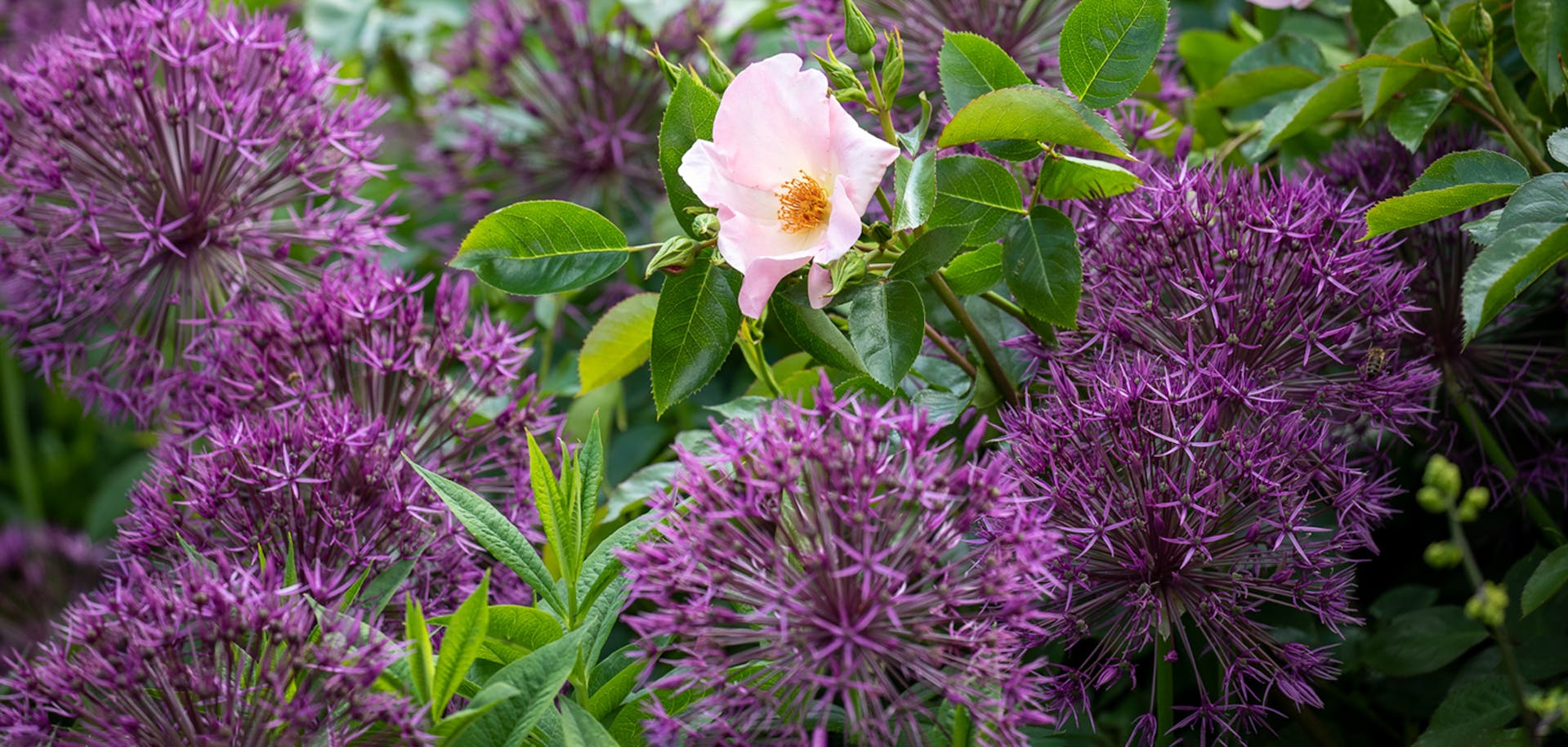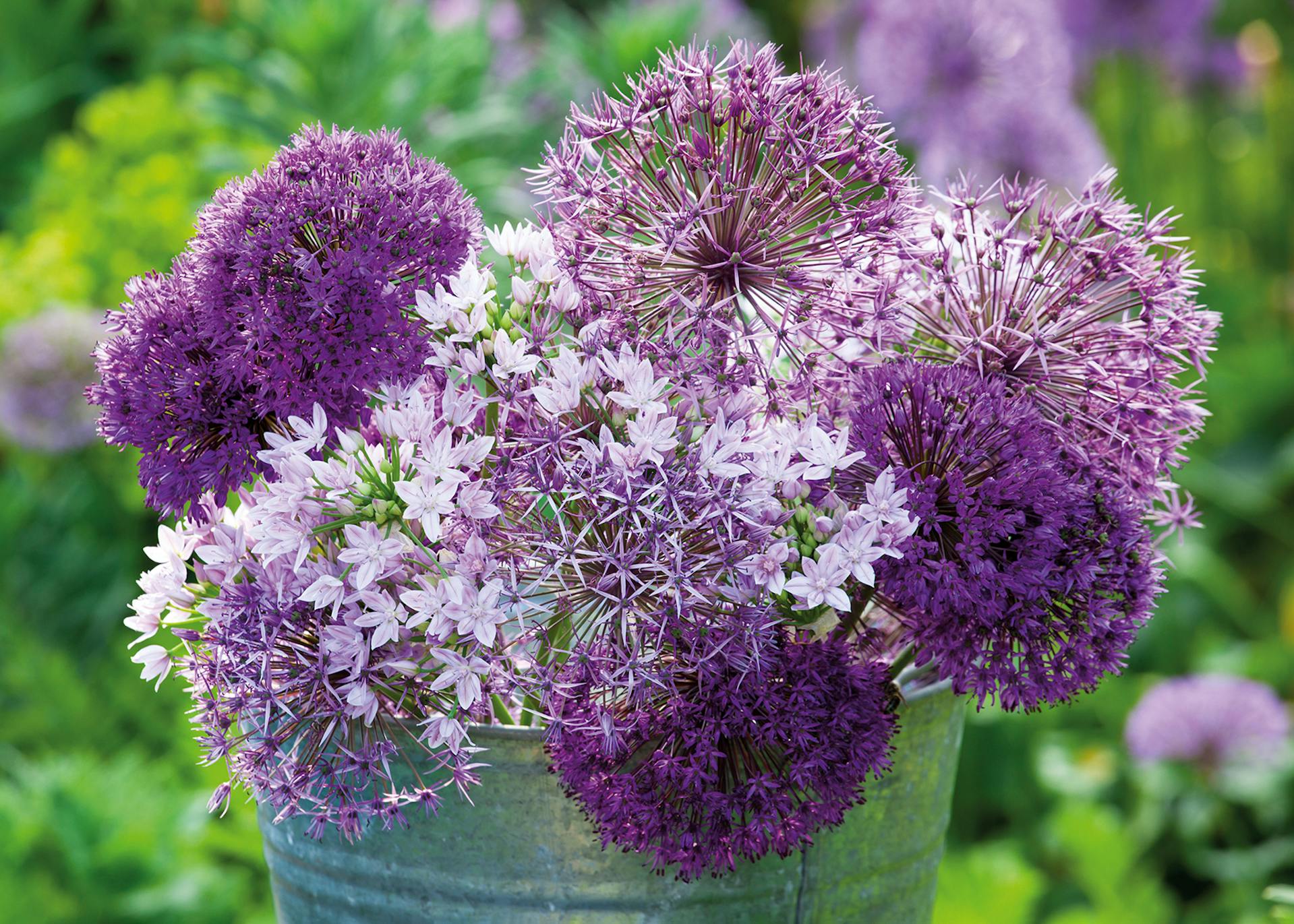How to plant, grow and care for alliums
Alliums are one of those plants that offer a huge amount of gorgeousness in return for the littlest amount of effort – you simply put them in the ground and they magically return spring after spring. They are hands down the bulbs that give me the greatest sense of achievement because they consistently provide weeks and weeks of drop dead glamour in the borders. Planted in swathes, their sparkler heads are just spectacular.
From the humble onion family, they are the unlikely sirens of the garden – their globes are held aloft on long, strong stems, and they are excellent for cutting when in flower or as dried, decorative seed pods. You can’t beat alliums for adding late spring and summer pizzazz – explore our range of allium bulbs in all shades of purple, as well as white and blue.
details
- Common name: Allium, Ornamental Onion
- Latin name: Allium
- Type: Perennial Bulb
- Height: 30cm (1ft) to 1.5m (6ft)
- TLC rating: Easy
- Aspect: Full Sun
- Planting position: Borders, Containers
- Suitable for pots: Yes
- Good for pollinators: Yes
- Good for cut flowers: Yes
how to grow alliums
where to grow alliums
Soil type: Alliums are best planted in well-drained soil but are fairly tolerant of a range of conditions, provided soil is not waterlogged. If you have heavy, clay soil, add grit to the planting holes.
Aspect & position: Choose a position in full sun for alliums, and if you are growing a very tall variety, a sheltered position is preferable to protect them from blowing over in the wind. Remember alliums are very perennial, so choose a permanent position for them that won’t be disturbed.
when to plant alliums
Alliums should be planted in autumn.
how to plant alliums
planting allium bulbs
Allium bulbs should be planted outdoors in autumn.
Dig a hole for each bulb, or if you are planting lots in one go, dig a trench. I tend to plant in good drifts, rather than in twos and threes to avoid a dotty look.
On heavy soil spread a 5cm (2in) layer of grit (or spent compost) over the bottom of the hole or trench.
As a general rule, make sure the hole is at least twice the depth of the bulb, and leave a gap of at least 3 times the bulb width between each bulb. For small- and medium-sized bulbs (such as ‘Purple Sensation’), this is around 10-15cm (4-6in) deep and 10-15cm (4-6in) apart. For the larger varieties (such as ‘Purple Rain’) it’s around 15cm (6in) deep, but at least 20-30cm (8in-1ft) apart as they need more space for their much larger flower heads and foliage. Giants like ‘Globemaster’ need to be 30-45cm (12-18in) apart to accommodate their gorgeous heads.
Place your bulbs on the bottom of the trench/hole and then cover them up – if on very heavy soil, mix in about one-third grit to two-thirds soil to fill in. After planting, firm the ground with your hand.

growing in alliums in a pot
Use good quality, peat-free, multipurpose compost and choose a nice deep pot.
Bulbs should be planted in pots at the same depth as bulbs grown in the ground. This may not always be possible with the largest bulbs, but ensure that a large bulb has at least 4cm (1½in) of compost beneath it. The spacing should also be the same as in the ground, so numbers will depend on the variety being planted.
Top-dress the pot with a generous layer of grit.
how to care for alliums
watering
Alliums are drought tolerant so are unlikely to need watering if planted in the ground; they will be watered by rain through the winter. If there’s a long dry spell in April or May, water accordingly, paying particular attention to pots which can dry out quickly.
fertilising
On poor soil, it’s worth giving almost all spring-flowering bulbs a potash feed in the early spring. This helps feed the bulbs and will encourage them to stick around and flower on and on for years. We use comfrey pellets, rich in natural potash.
deadheading
Alliums are usually grown for their ornamental heads which look good after they have gone to seed. If you want to minimise seedlings, you can remove the heads before the seeds ripen.
All bulbs do best if you minimize the number of leaves you cut when you pick the flowers.
As with all bulbs, it is best to leave the foliage to die back naturally so that the bulbs store as much energy as possible for the following year. However, in the case of alliums, if the foliage is really tatty and brown when they are in flower, there is no harm in removing it.

staking
If planted deeply enough, in full sun (so they don’t stretch toward the light), and in a sheltered position (so they don’t blow over in the wind), even the very tallest alliums won’t need staking, as their strong stems can support them.
dividing
Over a few years, allium bulbs can clump up by producing offsets, and a drift of alliums can become congested. When this happens, thin them out. When they have finished flowering, lift and divide them. Replant bulbs elsewhere in the garden, or share with a friend.
propagating
As well as lifting and dividing alliums, you can propagate the plant by seed – wait until the seedhead is dry and collect the seed to sow immediately or store and sow the following spring. Hybrids won’t be true to the parent plant and it can take several years to reach flowering size.
overwintering
Alliums are hardy so don’t need any special winter care. If you’ve grown them in containers, you can move the pots to a sheltered spot to stop the compost becoming waterlogged.
seasonal checklist
spring
- Early alliums, such as ‘Purple Sensation’, flower in May.
summer
- Enjoy a spectacular show of allium flowers.
- Water during a dry spell, paying particular attention to alliums in pots.
autumn
- Plant your allium bulbs in garden borders and in containers.
winter
- If the weather is very cold and wet, bring pots undercover or to a sheltered spot.
pests, diseases & common issues
Ornamental alliums are usually relatively problem free in the garden but can sometimes be affected by the diseases common to edible alliums like onions and garlic. Onion fly, allium white rot and downy mildew are all common issues for edible alliums that can sometimes affect the ornamental varieties. To help prevent this, avoid planting ornamental alliums where edible alliums have been planted before.
onion fly
The maggots of the onion fly (which looks like a small grey house fly) do the most damage, eating the roots of plants in the onion family. If this is happening, the plant may fail altogether, or you might notice yellowing leaves.
The bulbs should be dug up – if you see any maggots or larvae, dispose of the bulbs straight away.
allium white rot
This is a fungal disease that impacts the bulb and more commonly affects onions, garlic and leeks. The bulb will show signs of furry white growth and leaves might yellow and wilt. Bulbs should be disposed of – avoid planting any alliums in the affected area in the future as the fungus can survive in the soil for years.
downy mildew
Damp, wet weather can lead to downy mildew on alliums. You’ll see this show up as yellow, brown or pale green patches on the leaf surface and mouldy growth on the underside. Leaves may wilt and die.
Avoid congested clumps of alliums by lifting and dividing every few years to ensure good air circulation. Don’t overwater or allow soil or compost to become waterlogged. Pick off and dispose of any affected leaves.
allium leaf miner
Both the fly and the maggots of the allium leaf miner cause damage to alliums – the female flies puncture and feed on the leaves, while the larvae feed on the stems and bulbs. Both the flies and the pupae are about 3mm long. The plant is likely to show distorted or twisted leaves.

why are my allium leaves turning yellow?
Allium leaves will yellow and brown as they die back. If it’s too soon for that, it may be allium white rot.
why are my alliums not flowering?
Leave the browning foliage on your bulbs until every leaf has died right down so the photosynthesis provides food for the bulb.
Alternatively, it could be that the bulbs weren’t planted deeply enough, or the soil has become waterlogged, leading to bulb rot.
will squirrels or deer eat allium bulbs?
Squirrels and deer don’t tend to eat allium bulbs.
why are my alliums drooping?
Alliums are drought tolerant but they should be watered in a dry spell, and alliums in pots can dry out very quickly. Otherwise, it could be that the soil or compost is waterlogged – ensure good drainage.
why have my alliums died?
It could be one of the problems that affect the onion family, such as allium white rot. But if it’s just the leaves that are dying back, this is normal – the leaves come up early, in March, and start to die back while the allium is in flower.
frequently asked questions
do allium bulbs multiply and spread?
Yes, alliums are clump-forming perennials and they will increase in number each year if properly looked after.
do alliums self seed?
Yes, alliums can self-seed. They may not come true to the parent plant and it can take a few years for plants from seed to reach flowering size.
are alliums perennials?
Yes, alliums are perennial bulbs and will return each spring.
how do you dry alliums?
Pick fading seedheads and leave them somewhere cool and dry for a few months, such as a shed or cellar. I love to dry my seedheads and then spray paint them silver to use as Christmas decorations.
are alliums edible?
Onions, leeks and garlic are all part of the allium family, so many are everyday foods. While all alliums are technically edible, ornamental allium bulbs can be treated with chemicals, so avoid eating any intended as decorative garden plants.
are alliums poisonous to cats and dogs?
Yes, despite being part of the onion family (which is edible for humans), alliums are toxic to cats and dogs.
do alliums grow in shade?
Most alliums need full sun to grow strong and flower well. Nectaroscordum siculum (Allium bulgaricum) will take some shade.
are alliums good for bees?
Our alliums are covered in bees and other pollinators in spring. And we are told by our local beekeeper that the honey does not have an oniony taste!
where do alliums come from?
Different allium species are native to various regions of the world including North America, parts of Africa, Europe and Asia.
should I soak allium bulbs before planting?
No, you don’t need to soak allium bulbs before planting. Simply water them once planted if the soil is dry.
do alliums need staking?
If planted deeply enough in full sun (so they don’t stretch toward the light), and in a sheltered position (so they don’t blow over in the wind), even the very tallest alliums won’t need staking, as their strong stems can support them.
what to grow with alliums
Alliums can work very well when planted with artichokes and dahlias; watch Sarah talk about how she does this in the video below.
how to cut & arrange alliums

The sparkler heads of alliums look so glam in a vase! They will look good for up to 2 weeks without rearranging. To minimise the oniony smell, change the water regularly or add a splash of vinegar to the water. They also look fantastic dried so it’s worth collecting every flower head. You can find out more about turning your seedheads into festive decorations in this video.






